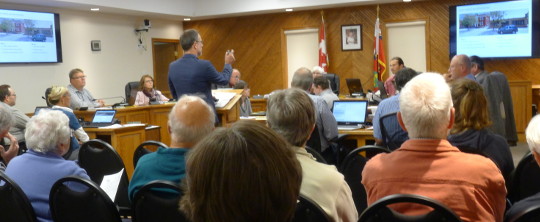Stephen Vance, Staff
At their September 26 meeting, Meaford council was presented with some options for merging the current library building with the municipal administration building located next door to create a larger, updated, and more accessible library.
Brock James of LGA Architectural Partners told council that the cost to carry out the project would be between $4.4 and $4.9 million, based on two design options prepared for the report to council. In recent years Meaford has been anticipating having to spend as much as $6 million (excluding land costs) on a new library building based on a study conducted in 2014.
The two design options presented would see the current library building renovated, including the addition of an elevator and linked to the administration building by a glass atrium-type enclosure, to create a useable space of between 8,700 to 10,000 square feet depending on the design option selected.
James noted that even if they aren’t merged into one facility, both buildings will require significant investments in the coming years for routine maintenance and upgrades totalling more than $760,000 over the next 25 years.
James’s presentation focused strictly on the design options and associated costs to merge the two buildings, and did not provide any indication of where the municipal offices would be moved to – and at what cost, or where the library might be moved for the anticipated 18 to 24 months of construction and renovation should the project move forward, though municipal staff indicated that they would be bringing a follow-up report to council to the October 3 council meeting.
While the library board has pledged to fundraise $1 million for a new library facility, funding the balance of a new library project will be the biggest hurdle.
“The long-term plan has always been that we’d have to borrow money for a portion, and hopefully get government grants,” Meaford Treasurer Darcy Champan told council, noting that there are currently no grant opportunities available for which the library project would qualify. “And the plan always included fundraising efforts by the library board, who for many years have said they’d be willing to fundraise for $1 million through the community to support this project.”
Chapman advised that if the library board was able to raise $1 million, and if Meaford had to take on debt for the remainder of the project without the aid of upper level government grant funding, it would add more than $220,000 per year to the municipal budget.
“A $3.5 million debenture over 20 years would be in excess of $220,000 per year in repayments,” advised Chapman.
Councillor Steven Bartley asked if, given the millions of dollars Meaford will need to spend on infrastructure costs in the coming years, a new library facility was even possible.
“I hate to be the bearer of bad news, but with the upcoming infrastructure needs of the municipality, for bridges and roads, the municipality cannot afford a new library,” suggested Bartley, noting that he had hoped that any library project would be largely funded by upper level government grants.
While no suggestion was offered as to where the municipal offices would be moved should the proposed connection of the two buildings move forward, in November of last year Chapman told council that even if Meaford doesn’t have an existing building that could accommodate the municipal offices, construction of a new administration building would cost considerably less than building a new library facility.
“An administration building can be less shiny,” Chapman told council at the time.
At the September 26 meeting Chapman told council that either way, there will be costs in the coming years for the two buildings.
“There’s $750,000 worth of (required) work over the next 25 years that need to happen at those two facilities irrespective. So whether it costs us $750,000 to move administration, or it costs us $750,000 to maintain the buildings, that dollar figure will be built in to the overall facility condition needs,” Chapman advised.
Meaford CAO Denyse Morrisey told council that more information will be provided at the October 3 council meeting.
“On October 3, staff will be coming back with a report based on what the consultant has outlined to us, and we’ll certainly be incorporating commentary to council on the impact to the administration, and what that would actually entail. We’ll also be commenting on capital investments that are critical over the next 10 to 15 years regardless, so that that investment can be put in the context of this project,” Morrissey told council.

One of two design options presented to council at their September 26 meeting.












